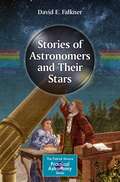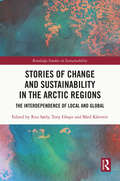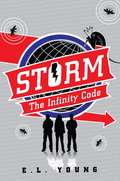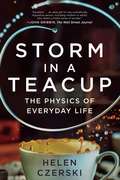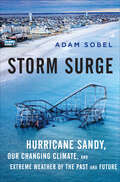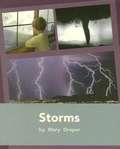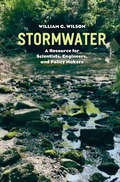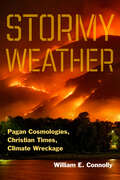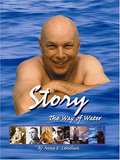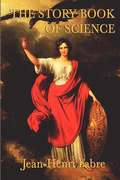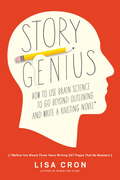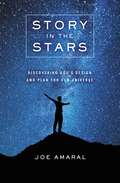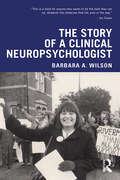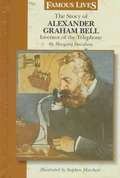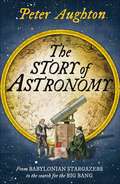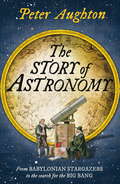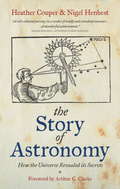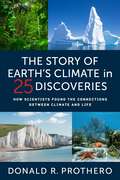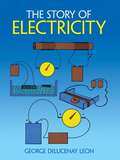- Table View
- List View
Stories of Astronomers and Their Stars (The Patrick Moore Practical Astronomy Series)
by David E. FalknerThis book recounts the stories of the astronomical pioneers who forever changed our views of the cosmos. The chapters delve into their fascinating lives over the centuries, showing how these pivotal minds built upon the work of their predecessors and unlocked the unique properties of specific stars. From ancient astronomy to modern imaging and spectroscopy, each tale at once showcases the pace of scientific discovery and the shared passions that drove these starwatchers. Accompanying the stories are a plethora of constellation and finder charts, stellar coordinates and directions, and suggestions for viewing specific stars, all of which are visible to the naked eye or through a small telescope. In addition, the histories on specific star names and designations are given, along with an overview of the most popular catalogues and online databases that readers can use for reference.
Stories of Change and Sustainability in the Arctic Regions: The Interdependence of Local and Global (Routledge Studies in Sustainability)
by Rita SørlyThis book presents stories of sustainability from communities in circumpolar regions as they grapple with environmental, economic and societal changes and challenges. Polar regions are changing rapidly. These changes will dramatically effect ecosystems, economy, people, communities and their interdependencies. Given this, the stories being told about lives and livelihood development are changing also. This book is the first of its kind to curate stories about opportunity and responsibility, tensions and contradictions, un/ethical action, resilience, adaptability and sustainability, all within the shifting geopolitics of the north. The book looks at change and sustainability through multidisciplinary and empirically based work, drawing on case studies from Norway, Sweden, Alaska, Canada, Finland and Northwest Russia, with a notable focus on indigenous peoples. Chapters touch on topics as wide ranging as reindeer herding, mental health, climate change, land-use conflicts and sustainable business. The volume asks whose voices are being heard, who benefits, how particular changes affect people’s sense of community and longstanding and cherished values plus livelihood practices and what are the environmental, economic and social impacts of contemporary and future oriented changes with regard to issues of sustainability? This volume will be of great interest to students and scholars of sustainability studies, sustainable development, environmental sociology, indigenous studies and environmental anthropology.
Storm: The Infinity Code
by E. L. YoungSTORM is a gadget-packed, high-adrenaline adventure-and also the name of a dynamic organization formed by three brainiac kids: WILL: loner, inventive genius, and creator of cutting-edge gear- STORM'S resident skeptic ANDREW: software whiz-kid and millionaire-STORM's founder, financial backer, and fashion disaster GAIA: brilliant and mysterious chemist-fluent in French, Italian, Mandarin, and blowing stuff up AT FIRST, Will scoffs at STORM's grand plans to combat global strife. But when the group uncovers a plot to create a deadly, revolutionary weapon, Will is forced to swallow his doubts-and fast. He, Gaia, and Andrew must race from London to St. Petersburg to find and dismantle the weapon, and confront the psychopathic scientist behind it all. But there's more to this wicked plot than meets the eye. Whether STORM is up to the task or not, one thing's for sure-their lives are never going to be the same.
Storm in a Teacup: The Physics of Everyday Life
by Helen CzerskiA physicist explains daily phenomena from the mundane to the magisterial. Take a look up at the stars on a clear night and you get a sense that the universe is vast and untouchable, full of mysteries beyond comprehension. But did you know that the key to unveiling the secrets of the cosmos is as close as the nearest toaster? Our home here on Earth is messy, mutable, and full of humdrum things that we touch and modify without much thought every day. But these familiar surroundings are just the place to look if you’re interested in what makes the universe tick. In Storm in a Teacup, Helen Czerski provides the tools to alter the way we see everything around us by linking ordinary objects and occurrences, like popcorn popping, coffee stains, and fridge magnets, to big ideas like climate change, the energy crisis, or innovative medical testing. She guides us through the principles of gases (“Explosions in the kitchen are generally considered a bad idea. But just occasionally a small one can produce something delicious”); gravity (drop some raisins in a bottle of carbonated lemonade and watch the whoosh of bubbles and the dancing raisins at the bottom bumping into each other); size (Czerski explains the action of the water molecules that cause the crime-scene stain left by a puddle of dried coffee); and time (why it takes so long for ketchup to come out of a bottle). Along the way, she provides answers to vexing questions: How does water travel from the roots of a redwood tree to its crown? How do ducks keep their feet warm when walking on ice? Why does milk, when added to tea, look like billowing storm clouds? In an engaging voice at once warm and witty, Czerski shares her stunning breadth of knowledge to lift the veil of familiarity from the ordinary. You may never look at your toaster the same way.
Storm Surge: Hurricane Sandy, Our Changing Climate, and Extreme Weather of the Past and Future
by Adam SobelWas Sandy a freak of nature, or the new normal?On October 29, 2012, Hurricane Sandy reached the shores of the northeastern United States to become one of the most destructive storms in history. But was Sandy a freak event, or should we have been better prepared for it? Was it a harbinger of things to come as the climate warms? In this fascinating and accessible work of popular science, atmospheric scientist and Columbia University professor Adam Sobel addresses these questions, combining his deep knowledge of the climate with his firsthand experience of the event itself.Sobel explains the remarkable atmospheric conditions that gave birth to Sandy and determined its path. He gives us insight into the science that led to the accurate forecasts of the storm from genesis to landfall, as well as an understanding of why our meteorological vocabulary failed our leaders in warning us about this unprecedented weather system—part hurricane, part winter-type nor'easter, fully deserving of the title "Superstorm."Storm Surge brings together the melting glaciers, the warming oceans, and a broad historical perspective to explain how our changing climate and developing coastlines are making New York and other cities more vulnerable. Engaging, informative, and timely, Sobel's book provokes us to think differently about how we can better prepare for the storms in our future.
Storms (Rigby PM Plus Blue (Levels 9-11), Fountas & Pinnell Select Collections Grade 3 Level Q)
by Mary Draper<P>A series of meticulously leveled fiction and nonfiction texts use recurring characters and authentic story lines that ignite student interest while systematically building high-frequency words and reading skills.
Storms From The Sun: The Emerging Science Of Space Weather
by Michael J. Carlowicz Ramon E. LopezFrom the casual conversation starter to the 24-hour cable channels and Web sites devoted exclusively to the subject, everyone talks about weather. There’s even weather in space—and it’s causing major upsets to our modern technological world. Space weather is all around us. There are no nightly news reports on space weather (yet), but we’re rapidly developing the tools necessary to measure and observe trends in cosmic meteorology. New probes are going on-line that help us monitor the weather taking place miles above the Earth. But why does space weather matter? It doesn’t affect whether we bring an umbrella to work or require us to monitor early school closings. It’s far, far away and of little concern to us . . . right? March 13, 1989. The Department of Defense tracking system that keeps tabs on 8,000 objects orbiting Earth suddenly loses track of 1,300 of them. In New Jersey, a $10 million transformer is burned up by a surge of extra current in the power lines. Shocks to a power station in Quebec leave 6 million people without electricity. New England power stations struggle to keep their power grid up. Listeners tuning in to their local stations in Minnesota hear the broadcasts of the California Highway Patrol. Residents of Florida, Mexico, and the Grand Cayman Islands see glowing curtains of light in the sky. All of these bizarre, and seemingly unconnected, events were caused by a storm on the Sun and a fire in the sky. A series of solar flares and explosions had launched bolts of hot, electrified gas at the Earth and stirred up the second largest magnetic storm in recorded history. Before rockets and radio and the advent of other modern devices, we probably would never have noticed the effects of this space storm. But in today’s electrically powered, space-faring world, the greatest space storm of the twenty-second solar maximum rang like a wake-up call. And we are now in the midst of another solar maximum, the effects of which are expected to be felt all the way through the year 2004. Storms from the Sun explores the emerging physical science of space weather and traces its increasing impact on a society that relies on space-based technologies. Authors Carlowicz and Lopez explain what space weather really means to us down here—and what it may mean for future explorations and colonization of distant worlds. By translating the findings of NASA and other top scientists into fascinating and accessible descriptions of the latest discoveries, we are privy to some of the most closely held secrets that the solar–terrestrial system has to offer.
Stormwater: A Resource for Scientists, Engineers, and Policy Makers
by William G. WilsonAs cities grow and climates change, precipitation increases, and with every great storm—from record-breaking Boston blizzards to floods in Houston—come buckets of stormwater and a deluge of problems. In Stormwater, William G. Wilson brings us the first expansive guide to stormwater science and management in urban environments, where rising runoff threatens both human and environmental health. As Wilson shows, rivers of runoff flowing from manmade surfaces—such as roads, sidewalks, and industrial sites—carry a glut of sediments and pollutants. Unlike soil, pavement does not filter or biodegrade these contaminants. Oil, pesticides, road salts, metals, automobile chemicals, and bacteria all pour into stormwater systems. Often this runoff discharges directly into waterways, uncontrolled and untreated, damaging valuable ecosystems. Detailing the harm that can be caused by this urban runoff, Wilson also outlines methods of control, from restored watersheds to green roofs and rain gardens, and, in so doing, gives hope in the face of an omnipresent threat. Illustrated throughout, Stormwater will be an essential resource for urban planners and scientists, policy makers, citizen activists, and environmental educators in the stormy decades to come.
Stormy Weather: Pagan Cosmologies, Christian Times, Climate Wreckage
by William E. ConnollyComposed as a counter-history of western philosophical and political thought, Stormy Weather explores the role western cosmologies have played in the conquests of paganism in Europe and the Americas, the production of climate wreckage, and the concealment of that wreckage from western humanists and earth scientists until late in the day. A lived cosmology, Connolly says, contains embedded understandings about the beginnings of the earth and the way time unfolds. The text engages the major western cosmologies of Augustine, Descartes, Kant, Tocqueville, together with pagan and minor western orientations that posed challenges to them or could have. Hesiod, Ovid, William Apess, Amazonian and Aztec cosmologies, Catherine Keller’s minor Christianity, James Baldwin, and Michel Serres instigate key responses, often challenging binary logics and the subject/object dichotomy with a world of multiple human and nonhuman subjectivities. Connolly pursues a conception of time as a multiplicity of intersecting temporalities to come to terms with the vicissitudes of climate destruction and the grandeur of an earth neither highly susceptible to mastery nor designed to harmonize smoothly with humans. The book revisits the “improbable necessity” of a politics of swarming to respond to the ongoing wreckage and potential fascist responses to vast infusions of climate refugees from the south into temperate-zone capitalist states. Stormy Weather draws on the work of earth scientists, indigenous thinkers, naturalists, humanists, and students of nonwestern cosmologies. Ultimately, Connolly contends that critical intellectuals today must not remain enclosed in disciplinary silos, or even in “the humanities” as currently defined, to do justice to our moment of climate wreckage.
Story: The Way of Water
by Anne E. LenehanStory Musgrave has an insatiable passion for life. From his childhood on a dairy farm in western Massachusetts, to payload commander on the Hubble Space Telescope rescue mission, share Story’s incredible physical and spiritual journey as he relates to the world, and the universe, around him. Based on a thematic biographical style, this intimate portrait of one of the world’s greatest thinkers, explorers and aviators is revealed through the eyes of Story himself, his family, friends and colleagues. Story is an American hero, renaissance man and, arguably, NASA’s greatest unofficial spokesperson - certainly one of the few with real vision and authenticity. This book has wide appeal to a variety of audiences. It is a human journey which happens to take place largely within the framework of the space program, but also encompasses themes such as mechanics, flying, nature, spirituality and humanity.
The Story Book of Science
by Jean Henri FabreFabre had many scholarly achievements. He was a popular teacher, physicist, chemist, and botanist. However, he is probably best known for his findings in the field of entomology, the study of insects, and is considered by many to be the father of modern entomology. Much of his enduring popularity is due to his marvelous teaching ability and his manner of writing about the lives of insects in biographical form.
Story Genius: How to Use Brain Science to Go Beyond Outlining and Write a Riveting Novel (Before You Waste Three Years Writing 327 Pages That Go Nowhere)
by Lisa CronFollowing on the heels of Lisa Cron's breakout first book, Wired for Story, this writing guide reveals how to use cognitive storytelling strategies to build a scene-by-scene blueprint for a riveting story. It's every novelist's greatest fear: pouring their blood, sweat, and tears into writing hundreds of pages only to realize that their story has no sense of urgency, no internal logic, and so is a page one rewrite. The prevailing wisdom in the writing community is that there are just two ways around this problem: pantsing (winging it) and plotting (focusing on the external plot). Story coach Lisa Cron has spent her career discovering why these these methods don't work and coming up with a powerful alternative, based on the science behind what our brains are wired to crave in every story we read (and it's not what you think). In Story Genuis Cron takes you, step-by-step, through the creation of a novel from the first glimmer of an idea, to a complete multilayered blueprint--including fully realized scenes--that evolves into a first draft with the authority, richness, and command of a riveting sixth or seventh draft.From the Trade Paperback edition.
Story in the Stars: Discovering God's Design and Plan for Our Universe
by Joe AmaralAn in-depth look at the powerful story and symbolism behind God's unique design of our universe.Thousands of words have been written about the first ten words in the Bible: "In the beginning, God created the heavens and the earth," a simple and profound statement that has ignited a firestorm of debate and controversy. People often only focus on the "how" and "when" of creation, but Story in the Stars explores the "why." Why did God create such a vast universe? Why did He choose the sun and moon to light our paths? Why did He design images with stars in the night sky?The Bible is very clear when it states that God created, named, and positioned all of the stars of the universe in their place in a very specific way-a way that tells us the greatest story ever to be told. In Luke 21:25 Jesus says, "There will be signs in the sun, moon and stars." Signs are meant to point us towards something: Jesus. Story in the Stars takes an in-depth look at the Bible and all the signs God mapped out through constellations, planets, and even the way the Earth is tilted. We are uniquely designed by God, and He loves us so much that He ensured a way for all inhabitants of the earth, through all of time, to see the messages of salvation and redemption that He painted in the stars.
The Story of a Clinical Neuropsychologist
by Barbara A. WilsonFrom a disadvantaged childhood to becoming one of our best-loved clinical neuropsychologists, this exceptional book tells the life story of Barbara A. Wilson, who has changed the way we think about brain injury rehabilitation. Barbara’s story shows how it is possible to have a fulfilling career alongside a successful family life, even when faced with the deepest of personal tragedies; the death of her adult daughter Sarah. Clinical and neuropsychologists will recognise Barbara’s influence on rehabilitation practice and her tireless aim to get what is best for people needing neuropsychological rehabilitation. It will inspire those with brain injury and their families who may struggle to make life meaningful, as well as encourage readers to stick to their beliefs and triumph in the face of obstacles.
The Story of Albert Einstein: An Inspiring Biography for Young Readers (The Story of Biographies)
by Susan B. KatzDiscover the life of Albert Einstein—a story about asking questions and discovering big things for ages 6 to 9Albert Einstein became one of the most important scientists in history for his discoveries about physics and how our universe works. Before everyone knew him as a genius, Albert was a curious kid who loved reading, learning, and experimenting with new ideas. He asked big questions and wasn't afraid to make mistakes. Explore how Albert Einstein went from being a young Jewish boy growing up in Germany to the most celebrated physicist ever.Independent reading—This Albert Einstein biography is broken down into short chapters and simple language so kids 6 to 9 can read and learn on their own.Critical thinking—Kids will learn the Who, What, Where, When, Why, and How of Albert's life, find definitions of new words, discussion questions, and more.A lasting legacy—See Albert progress from curious kid to famous scientist with a visual timeline!How will Albert Einstein's life encourage your own curiosity about the world?Discover activists, artists, and athletes, and more from all across history with the rest of The Story Of series, including famous figures like: Marie Curie, Ruth Bader Ginsburg, Leonardo Da Vinci, Anne Frank, and Benjamin Franklin.
The Story of Alexander Graham Bell, Inventor of the Telephone
by Margaret DavidsonA readable, interesting biography of the famous inventor, paying equal attention to his scientific achievements, his personal life, and his lifelong work with the deaf. There are several odd omissions, though, including why Bell adopted the middle name Graham; the spilled-acid aspect of the first telephone message and Bell's demonstration of the telephone before Queen Victoria.
The Story of Apollo 11 (Cornerstones of Freedom)
by R. Conrad SteinHighlights man's efforts to journey to the moon, with a detailed account of the first landing achieved by Apollo 11.
The Story of Astronomy
by Peter AughtonFrom the ancient origins of astronomy to the Copernican revolution, and from Galileo to Hawking's research into black holes, The Story of Astronomy charts the discoveries of some of the greatest minds in human history, and their attempts to unveil the secrets of the stars. Peter Aughton's trademark narrative style is to the fore, demystifying some of the biggest breakthroughs in the history of science, and packed full of fascinating nuggets such as why we have 60 minutes in an hour, how the Romans bodged the invention of the leap year and when people really discovered the Earth wasn't flat (a thousand years before Columbus). And explaining in the most straightforward and compelling of ways what Newton, Einstein, Hubble and Hawking really achieved.
The Story of Astronomy
by Peter AughtonFrom the ancient origins of astronomy to the Copernican revolution, and from Galileo to Hawking's research into black holes, The Story of Astronomy charts the discoveries made by some of the greatest minds in human history, and their attempts to unveil the secrets of the stars. Written in an accessible and entertaining style, The Story of Astronomy demystifies some of the biggest breakthroughs in the history of science, as well as explaining why we have 60 minutes in an hour, how the Romans bodged the invention of the leap year and when people really discovered the Earth wasn't flat (a thousand years before Columbus. In the most straightforward and compelling of ways Peter Aughton demonstrates the beauty and wonder of what Newton, Einstein, Hubble and Hawking really achieved.
The Story of Astronomy
by Peter AughtonFrom the ancient origins of astronomy to the Copernican revolution, and from Galileo to Hawking's research into black holes, The Story of Astronomy charts the discoveries made by some of the greatest minds in human history, and their attempts to unveil the secrets of the stars. Written in an accessible and entertaining style, The Story of Astronomy demystifies some of the biggest breakthroughs in the history of science, as well as explaining why we have 60 minutes in an hour, how the Romans bodged the invention of the leap year and when people really discovered the Earth wasn't flat (a thousand years before Columbus. In the most straightforward and compelling of ways Peter Aughton demonstrates the beauty and wonder of what Newton, Einstein, Hubble and Hawking really achieved.
The Story of Astronomy: How the Universe Revealed its Secrets
by Nigel Henbest Heather CouperJourney through time and space with the greatest astronomers in history. Astronomy is one of the oldest of all the sciences. And yet, its history is also so much more than the history of a science, reflecting our entire culture and providing insight into the evolution of humankind's ideas and ideals over the centuries. This fascinating book tells the amazing story of the development of astronomy, through the key characters in its history from Copernicus to Hubble and Halley, the excitement of new discoveries and the ways in which the history of the skies has affected our lives and how we look at the planet on which we live.The Story of Astronomy celebrates changing perspectives (from the Ancient Greeks to the latest scientific advances) as different cultures, philosophers and scientists sought to come to terms with their, and earth's, place in the Cosmos.Exhaustively researched and containing interviews with many of the world's leading astronomers, including Stephen Hawking, this is the ultimate history of how the universe has revealed itself to us over the millennia.
The Story of Astronomy: How the universe revealed its secrets
by Nigel Henbest Heather CouperJourney through time and space with the greatest astronomers in history. Astronomy is one of the oldest of all the sciences. And yet, its history is also so much more than the history of a science, reflecting our entire culture and providing insight into the evolution of humankind's ideas and ideals over the centuries. This fascinating book tells the amazing story of the development of astronomy, through the key characters in its history from Copernicus to Hubble and Halley, the excitement of new discoveries and the ways in which the history of the skies has affected our lives and how we look at the planet on which we live.The Story of Astronomy celebrates changing perspectives (from the Ancient Greeks to the latest scientific advances) as different cultures, philosophers and scientists sought to come to terms with their, and earth's, place in the Cosmos.Exhaustively researched and containing interviews with many of the world's leading astronomers, including Stephen Hawking, this is the ultimate history of how the universe has revealed itself to us over the millennia.
The Story of Chemistry
by N. C. DattaThe study of the history of science is essential for understanding the development of scientific thought. It enables one to realize the tribulations and travails of the people who make scientific discoveries possible.
The Story of Earth's Climate in 25 Discoveries: How Scientists Found the Connections Between Climate and Life
by Donald R. ProtheroOver 4.5 billion years, Earth’s climate has transformed tremendously. Before our more temperate recent past, the planet swung from one extreme to another—from a greenhouse world of sweltering temperatures and high sea levels to a “snowball earth” in which glaciers reached the equator. During this history, we now know, living things and the climate have always influenced and even shaped each other. But the climate has never changed as rapidly or as drastically as it has since the Industrial Revolution.In this lively and entertaining book, Donald R. Prothero explores the astonishing connections between climate and life through the ages, telling the remarkable stories of the scientists who made crucial discoveries. Journeying through the intertwined evolution of climate and life, he tackles questions such as: Why do we have phytoplankton to thank for the air we breathe? What kind of climate was necessary for the rise of the dinosaurs—or the mammals, their successors? When and how have climatic changes caused mass extinctions? Prothero concludes with the Ice Ages and the Holocene, the role of climate in human history, and the perils of anthropogenic climate change. Understanding why the climate has changed in the past, this timely book shows, is essential to grasping the gravity of how radically human activity is altering the climate today.
The Story of Electricity: With 20 Easy-to-Perform Experiments
by George De LeonEasy-to-follow instructions for performing 20 famous experiments that led to major discoveries in electricity and magnetism over the past 2,500 years. Safe, clearly illustrated projects involve compasses, batteries, electromagnets, thermocouples, generators, more. List of inexpensive, readily available materials. Grades 4-6.
